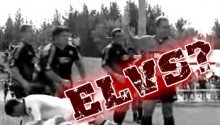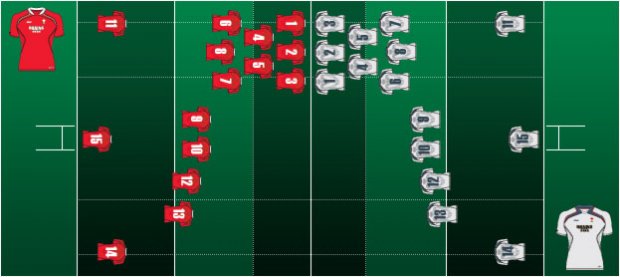Going back into the dim, dark past and reading what you wrote about two years ago can be a risky business. However, in this instance I feel totally justified and indeed, even a shade hubristric.
In the post I’m referring to of late 2009, Short Arm, Short Shrift, Good Riddance , I said that the Experimental Law Variations introduced to Australian rugby were a load of old bollocks and applauded their demise. In particular, the ELV sanctions that turned the game into a touch rugbyfest and devalued the scrum.
 The reason I’ve turned back time and looked at this again is because I was reminded of it the other day with the non-selection of a true No 7 backup to David Pocock in our RWC squad.
The reason I’ve turned back time and looked at this again is because I was reminded of it the other day with the non-selection of a true No 7 backup to David Pocock in our RWC squad.
In my view, this is a dangerous risk to take — and don’t tell me the All Blacks are doing it as well because they’re not, Adam Thompson (injury notwithstanding) has played test rugby as a No 7 before.
Robbie Deans is saying in justification that there’ll be less emphasis at pilfering at the breakdown and more on physicality. That’s all well and good until David Pocock gets injured. I think I’d rather have a Francois Louw as my backup than a Ben McCalman.
Anyhow, back to the ELVs — the No 7’s in particular became a direct beneficiary of the dumping of the principal ‘Stellenbosch Laws’. There wasn’t a law change or anything after the ELVs were discarded, just a change in interpretation and game management by the referees. As simple as that…
The Northern Hemisphere hated the ELVs because of the de-emphasis on the scrum and tight forward play in general. You could understand that to some extent, as the conditions in the UK are culturally forward-orientated and not necesarily expansive. That probably has something to do with the weather and conditions underfoot?
I suppose they also don’t have AFL and league breathing down their neck, but just play second fiddle to soccer only — they know their place! The ARU was very supportive of adopting the ELVs primarily due to the competitiveness of the Australian sporting environment and their desire for a more running, hence ‘attractive’, game.
I loathed the use of short arm penalties for everything at the breakdown except offside and foul play, and the ‘use it or lose it’ law at the ruck. The attacking team was disadvantaged and penalised if they didn’t recycle quick-smart.
There was a plethora of short arm penalties throughout a game, ruining continuity and given it ‘fluff appeal’. Incorrect kick restarts were free kick material, and even if you didn’t throw the ball straight into a lineout.
It was as if the word ‘scrum’ had become dirty? Maybe in those days our frontline props spent a fair bit of time re-setting after spearing into the dirt but at least now it’s policed as a matter of course.
It was great for the running halfback who quick-tapped and go’ed. This was tailor made for someone like Luke Burgess and saw him at his peak. I’ve no doubt Will Genia would have been a hit at it as well.
The ELVs came about because the IRB wanted to investigate ways of speeding up the game and keeping the ball in play more. Although the program began before the 2007 Rugby World Cup, it gained a life of its own after the dirge delivered in the leadup to the RWC, and especially the final of that tournament.
Although the Stellenbosch Laws canvassed a whole array of unique and ‘think outside the square’ solutions, many were adopted by the IRB but not the main ones vociforously supported by Australian ‘zealots’. South Africa and New Zealand rugby authorities were both decidedly lukewarm on some of the initial trialled changes.
The South Africans in particular were under the pump, especially when they had to play the British & Irish Lions in the old format after just completing the Super 14 in the new. How stupid was that?
In the end, there were some positive law changes that came out from the trial. Those included:
- More power to the ‘Assistant Referee’.
- The ‘carry back’ law from scrum, ruck or lineout into the 22.
- The quick throw-in now doesn’t have to be straight, as long as it’s not forward.
- The offside line at a scrum is now 5m back from last feet.
- Lineout players can pre-grip a jumper before the ball is thrown in.
- The lifting of lineout jumpers is permitted.
- The corner posts are no longer considered to be in touch in-goal.
 Importantly, the emphasis (referee’s interpretation and game management) has now been rightly focussed on the tackler at the breakdown in the first instance, requiring him to release and roll-away.
Importantly, the emphasis (referee’s interpretation and game management) has now been rightly focussed on the tackler at the breakdown in the first instance, requiring him to release and roll-away.
Secondly, the tackler can immediately get to his feet and play the ball even if a ruck forms around him and thirdly, an arriving player on his feet can also play the ball under the same conditions as (2).
This has tidied up the breakdown significantly, allowing for quicker ball and more continuity, which leads to tries as defences are caught out before they have time to re-align and adjust.
Let’s hope that in the RWC this interpretation remains in the frame with the ‘chosen’ referees. For me, the ELV’s are gone and long forgotten. May they rest in peace forever….



